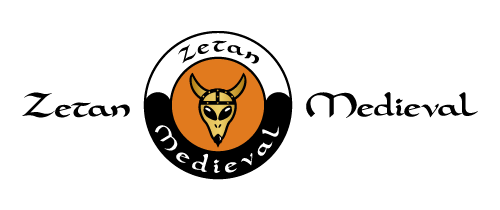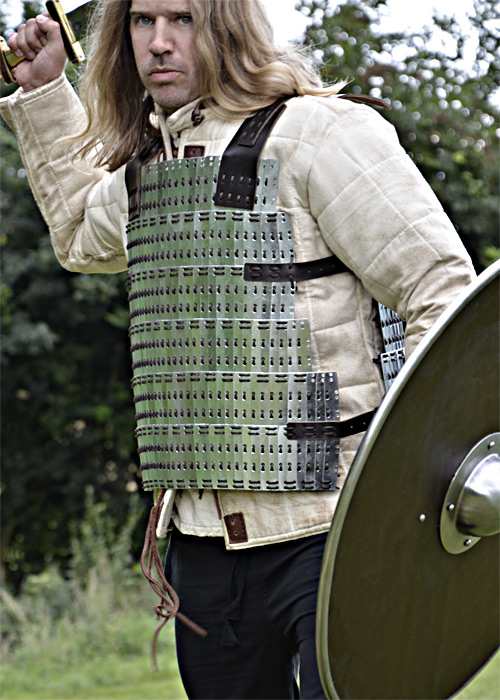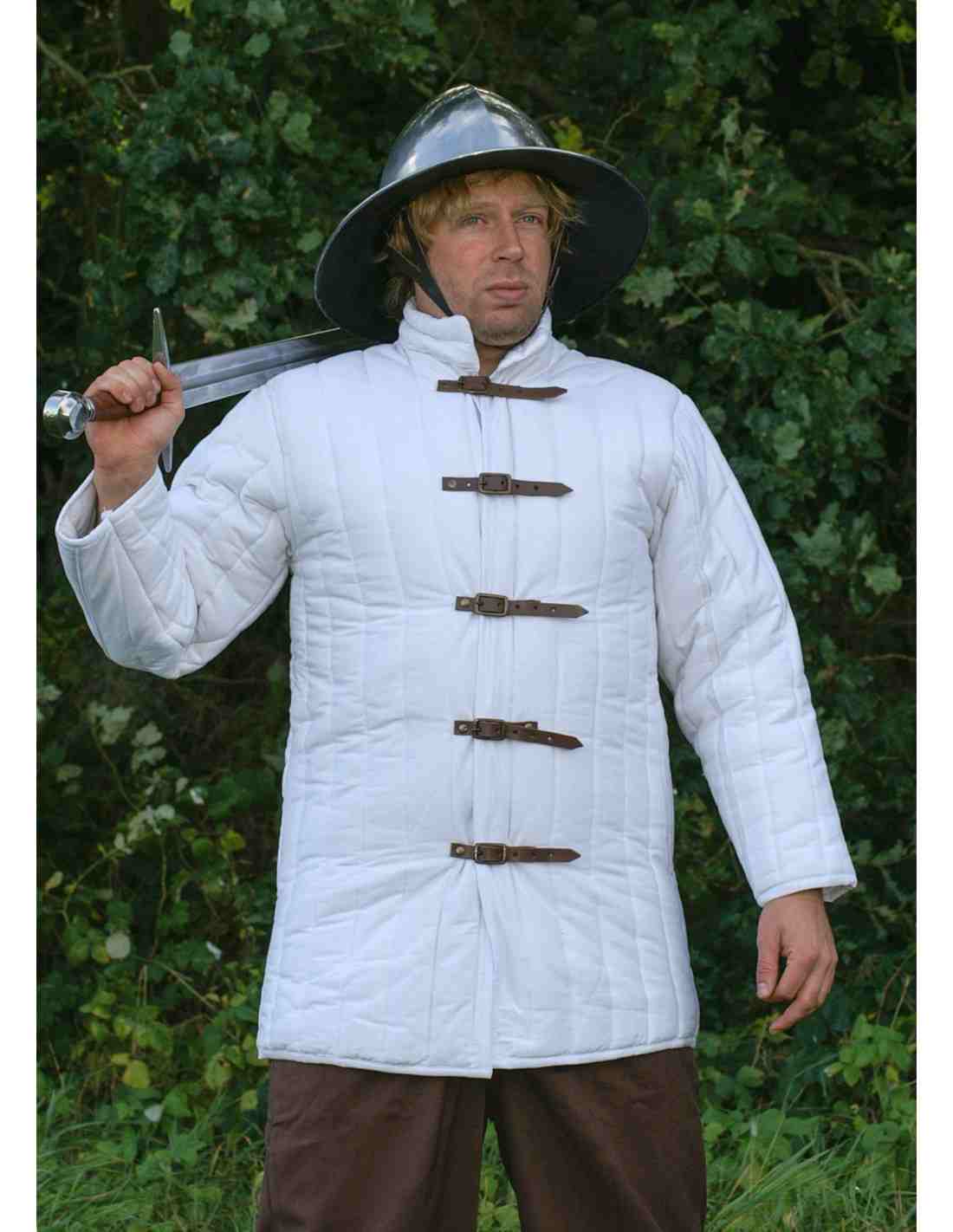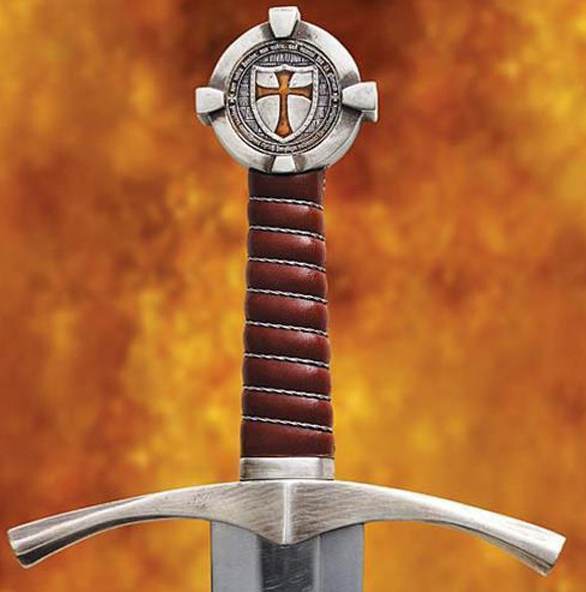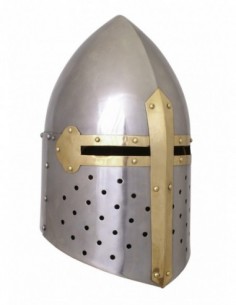The gentleman's clothing. - A very important part of his clothing, since its absence exposed the knight to burns due to the heating of the armor by solar action. Among his articles of clothing we can mention: the gipoun (short cassock) made up of a shirt and linen underpants, very tight to the body to prevent the skin from rubbing against the armor from causing skin injuries to the knight. Over their clothing they wore the gambeson , which was a linen-based padded garment. They often wore cloaks to protect themselves from the cold or rain. The less affluent only wore a thick cloth tunic called a fustian.
Above the armor, the knight wore the surcoat, it was a long tunic in which the knight's shield could be distinguished, and this was the only means of distinguishing some knights from others. The surcoats were open at the bottom for purely physiological reasons. Other complementary elements were hats and headdresses. Evidently they also wore around their waists a large belt from which a leather bag usually hung . On the legs they wore a kind of woolen leotard . The shoes were leather. They were closed, gradually imposing the pointed shoe. They also wore underwear such as breeches that were tied at the waist and knees. The material from which they were made was linen. It seems that they were not fitted with a codpiece. This characteristic, so usual in men's clothing in modern life, is said to have a Turkish origin and its objective was not the usual one of our times, but to be able to rape women without having to lower their pants. Over the breeches, the gentleman put on the breeches , made of fine leather or linen. These leggings could end in leather soles, as they could thus replace shoes . Mesh leggings were put on top of the leather leggings, to which brafoneras were added , a piece that normally covered the upper part of the arm, but which in this case helped to protect the leg.
On the shirt the warrior wore the perpunte . Its composition was made of cloth filled with tow and served to attenuate the blows received with heavy weapons. They had openings in front and behind to allow riding a horse. In addition, the head was covered with the arming cap , a stuffed hood, normally, of the same material as the perpunte, which was attached to the chin. The cap prevented friction with the chain mail and was also an element that cushioned blows received on the head.
We have seen how a warrior dressed in the upper and lower part of his body. Now we will see describe other fundamental elements in knightly clothing. The mail shirt, which could have the built-in coif . Its clothing was one-piece, so it had to be dressed over the head. His weight ranged between 20 or 25 kilos. They could have short or long sleeves, and some even reached the wrists. The mittens were the essential element to protect the hands and on the inside they were made of leather so that the warrior could have a good grip on his weapon. If they did not wear mittens, their hands were exposed to great risk, since gloves had not yet been invented. The mail shirt also had slits in front and back for horseback riding.
Another of the devices intended for the protection of the knight is without a doubt the coif, (garment of which we have already spoken previously). which is a variety of cap or mesh hood , which was placed under the helmet , which was a metal helmet without plume or visor. The helmet is the forerunner of the helmet, and it differs from that in that, in addition to the head, it protected the face, and wore a visor . There are many types of coifs: 1.- Square in shape made of leather and mesh that is tied to the head. 2.- Leather-lined mesh that is tied to only one side of the head. These 2 types of models fit perfectly with the conical helmets or capiellos . For crest helmets , which are those that generally show the effigy of a chimerical animal on the upper part, a burelete, a twisted piece of leather or cloth, had to be used as a coif that helped to attach the helmet to the head and was placed in the upper fraction of the helmet. Other, more sophisticated coifs were, for example, a coif to assemble, which already incorporated the burelete and also added a protection for the neck . Some of these pieces could be opened at the back in order to achieve a better fit to the head.
The level of plates. Surcoat made of a single cut in leather or fabric that had riveted metal plates inside. He weighed about 10 kilograms, which together with everything he already had on him, the gentleman would have to support a not inconsiderable weight of 50 kilograms.
In addition to everything seen previously, the knight completed his clothing by wearing the coat of arms, which was a fabric dress with half sleeves, although it was also common to see coat of arms without sleeves. Sometimes they were so wide that they covered the horse's rump. As is to be expected, they also wore spurs or spurs (spurs with a single iron point).
By adding weapons to the weight of their clothing, it could be assumed that these warriors had greatly reduced mobility, and on this issue there are 2 theories: those who affirm that, in effect, a knight who fell from his horse was a dead man, since he barely they could move while being at the mercy of the enemy on duty, while others defend that, despite their weight, they were very agile men, and this was due to the hard training to which they were subjected as children, which transformed them into fibrous, very stocky individuals, and accustomed to stoically endure the cold, the heat and the rain without failing. Nowadays it would be considered heroic just to ride with all that for half an hour... and that without going into battle. Anyway… those were other times .
Although we have already described the knight's harness or armor , it is unnecessary to summarize the pieces that made it up.
The cuirass It covered the upper part of the body. From the waist to the beginning of the legs, they wore the skirt , made up of metal plates, called launas and also added to this a metal skirt. The purses specially designed to protect the thighs (Also called quixote ) and, in the back part, another element called the culera was included .
For the legs , the knee pad and the greave were used. that covered the leg from the knee to the ankle. To protect the feet were the booties , formed by sheets of iron attached to each other.
For the arms, we find the shoulder pads and elbow pads.
For hands : mitts (fingers were not separated, except for the thumb) and gauntlets . (the fingers are separated), they performed the same function.
Head protection : It could be a simple steel helmet, with an iron bar that safeguarded the nose. Another more sophisticated element was the helmet , essential for combat to limit the action of the blows that the knight wore on the head. Underneath was the cap, cloth cap, specially made of wool. In it thirteenth century it was cube-shaped and in one piece. Its top was flat. Its weight was remarkable, being used only in combat . Since the 14th century, it has undergone several modifications, both in weight and in shape. In addition, a visor that could be opened and closed is added.
The gambeson , of which we have already spoken, was a shirt made of leather, wool or linen, to protect the warrior's skin from rubbing against the armor. It was filled with cotton. It reached to the knees and had long sleeves. But it was not the only model, there being a great variety of prawns. Several segments of chain mail were usually sewn to the gambeson.
As we saw when talking about the helmet, the cap is a piece that is placed under the helmet, to help defend the head from blows received. It was made of cloth and padded, and was fixed to the head by means of two strips of cloth knotted under the chin.
The knight's armor from the 14th century ended the problems of the 13th century chain mail, from which it was derived by adding pieces of metal until it reached the configuration of the time. They were made by craftsmen, and therefore very expensive, which eliminated the poor from owning one of these armors. The armor gave the knight an aura of mysticism, as it was believed that the knight dressed in his armor gave off an aura of invulnerability. Even though they were heavy, they were not as heavy as the armor of the 13th century, which, in addition to better protection, offered them a chance to move better.
Continuing with the armor and other elements, we are going to talk about the overcoat to cover the lower part of the breastplate. The backrest also had a complementary protection called support for the lower back. The guardrail protected the kidney area. The barbot or gorget intended for the protection of the neck and an area of the warrior's face.
The warrior's footwear consisted of boots or shoes, they were usually made of leather.
An essential item for the knight in combat was the shield . This could be made of wood, leather or metal.
The cape was also part of the clothing of the medieval warrior. It was worn over armor and was made of wool or silk.
The tabard was a short sleeveless cloak worn over armor. It could be made of silk or linen and sometimes we could find emblems referring to the social situation of the gentleman.
Padded pants : Made of thick thread cotton. They were worn under armor and protected the legs.
Skirt : It covered the lower part of the body and was carried under the armor. How the tabard could be decorated.
Hood : It was cloth. It covered the head and neck and protected the wearer from the sun, rain and cold.
Belt : Tele or leather was worn around the waist. cloth or leather worn around the waist to hold certain parts of the armor, in addition to the sword and dagger.
Band for the arm : Piece of cloth whose function was to be a badge of the status of the gentleman.

